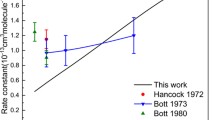Abstract
Potential curves for the lower unbound Hg2(XO + g ) state and the upper Hg2(D1 u ), state of the mercury dimer are determined by multiply repeating calculations of the desired spectrum and comparing the results obtained with the experimental data. Initial Morse potentials are supplied with patches, making the potentials steeper on one of its wings and more flattened on the other wing compared to the usual Morse potential. The values of ω e and ω e x e for the Hg2(XO + g ) and Hg2(D1 u ) states are determined according to several lowest vibrational states of the terms. Coordinates of turning points are also given for the corresponding states. These data seem to be useful in studying the mercury dimer by the traditional method with a low vibrational excitation.
Similar content being viewed by others
References
J. G. Eden, H. C. Tran, and V. S. Zuev,J. Russ. Laser Res.,19, 120 (1998).
R. B. Jones, J. H. Schloss, and J. G. Eden,J. Chem. Phys.,98, 4317 (1993).
R. S. Mulliken,Rev. Mod. Phys.,2, 60 (1930);3, 89 (1931).
L. D. Landau and E. M. Lifshitz,Quantum Mechanics [in Russian], GIFML, Moscow (1963).
G. Herzberg,Spectra of Diatomic Molecules, D. van Nostrand Co., Princeton (1950).
K. V. Nikol'skii,Quantum Mechanics of Molecules [in Russian], GTTI, Leningrad (1934).
L. A. Kuznetsova, N. E. Kuz'menko, Yu. Ya. Kuzyakov, and Yu. A. Plastinin,Probabilities of Optical Transitions for Diatomic Molecules [in Russian], Nauka, Moscow (1980).
V. B. Berestetskii, E. M. Lifshitz, and L. P. Pitaevskii,Quantum Electrodynamics [in Russian], Nauka, Moscow (1989).
W. C. Stwaley,Phys. Rev. Lett.,37, 1628 (1976).
P. S. Julienne,J. Res. NIST,101, 487 (1986).
W. Kohn and J. A. Pople, in:Physics News Update, (1998), No. 397.
M. Dolg and H.-J. Flad,J. Chem Phys,100, 6147 (1996).
J. Koperski, J. B. Atkinson, and L. Krause,Chem. Phys. Lett.,219, 161 (1996).
A. Zehnacker, M. C. Duval, C. Jouvet, et al.,J. Chem. Phys.,86, 6565 (1987).
Author information
Authors and Affiliations
Additional information
Translated from a manuscript submitted January 28, 1999.
Rights and permissions
About this article
Cite this article
Eden, J.G., Tran, H.C. & Zuev, V.S. Photoassociation spectrum for the Hg2(XO + g )→Hg2(D1 u ) transition: The hund's (C) case. J Russ Laser Res 20, 342–348 (1999). https://doi.org/10.1007/BF02508654
Issue Date:
DOI: https://doi.org/10.1007/BF02508654




